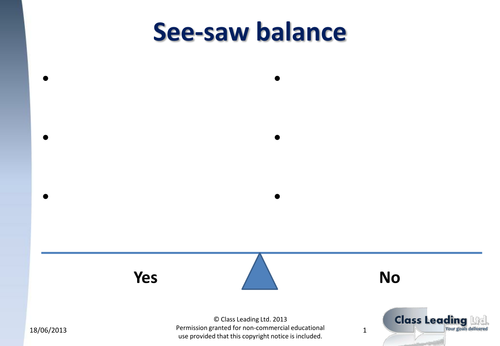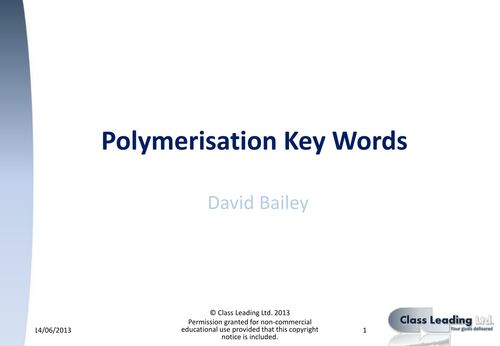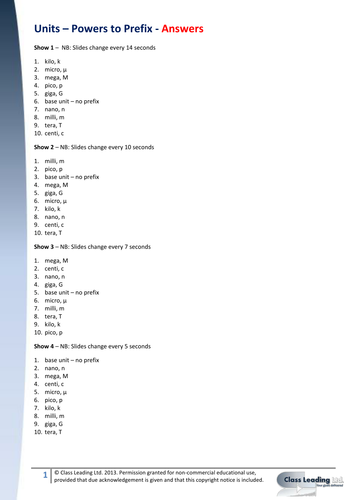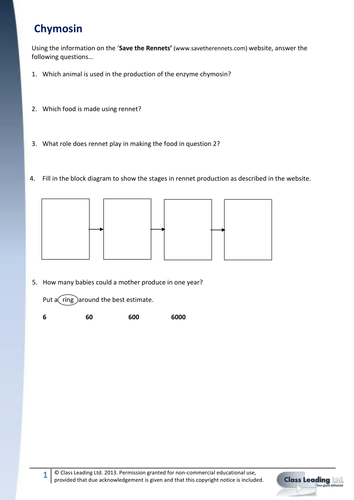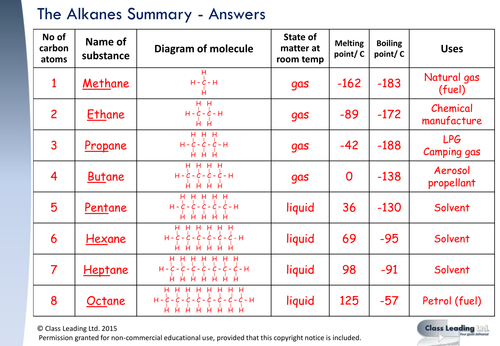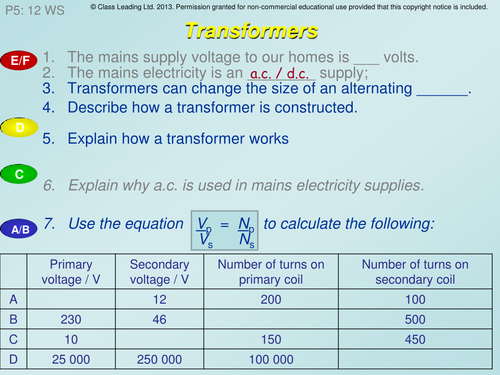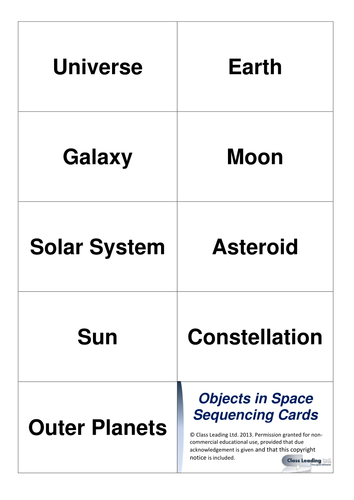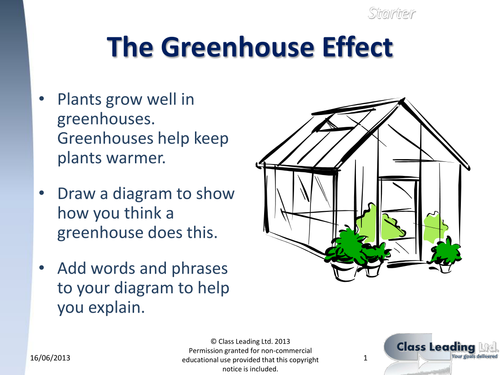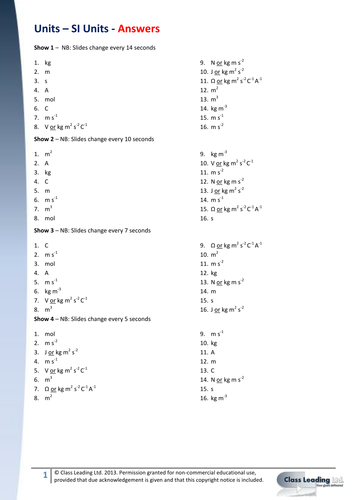312Uploads
256k+Views
192k+Downloads
All resources

Weighing up arguments - See saw writing frame
This resource is a collection of 6 slightly different see-saw balances that can be used with learners to help them develop the skills to weigh up an argument. The idea is that students will list reasons on both side of an argument (e.g. Should we have Nuclear Power?). They then use this to help make a decision. The scoring column on some sheets allows learners to score each argument out of a maximum of say 3. Add the scores on each side to see which has the stronger argument. This also includes phrases to support a more detailed conclusion. This was inspired by 21st Century Science.

Eating a sandwich - modeling digestion
There are two parts to this activity, one is a practical activity to model the process of digestion. The other is a powerpoint slideshow to show what happens to the food on its journey through the body. If using with KS3 then the learning outcomes on the activity plan could also include breaking up of molecules in digestion. If using with KS2 for the new curriculum, the powerpoint will include some terms/slides that you may wish to miss out, so it has been left in an editable form.\nPlease ensure that you carry out a risk assessment before carrying out a practical activity.

Polymerisation Key words & meanings - Display
This is a pdf showing some key words for polymerisation, including the meaning of the words. They are suitable for printing onto A4 (or scaling up to A3) for display purposes. Remember if laminating them for wall display to ensure that non-reflective laminates are used where possible to ensure maximum readability.
Keywords: monomer, polymer, polymerisation

Capturing Seasonal Change
This activity is aimed at KS1 learners exploring seasonal change. Due to the nature of seasonal change, the suggested activity is intended to be run over a long period of time (up to one year).

The carbon cycle - grade questions
This activity contains a powerpoint with graded questions & answers and matching pupil activity sheets, designed to be used at the end of a lesson and/or the start of the next lesson to review previous learning. The questions are based on the previous OCR 21st Century Science Specification unit P2, although could be used with other exam boards.\nClicking through the show reveals answers one a time. These reduce to A5 easily, the ideal size for most pupils. Please note grades are approximate.

Maths Skills - Units - Powers to Prefix Starter
These are a sequence of powerpoint shows designed as an instant engagement task (rolling on screen as learners enter the room for immediate engagement with learning). Learners write down the prefix that represents the power of ten multiplier. They are essentially the same task (with rearranged slides) but get progressively more demanding (as the changeover of slide gets faster) as the numbers in brackets increase. Start the students with (1) and then as they get faster, use the more demanding versions.

Work & change of energy - graded questions
This activity contains a powerpoint with graded questions & answers and matching pupil activity sheets, designed to be used at the end of a lesson and/or the start of the next lesson to review previous learning. The questions are based on the previous OCR 21st Century Science Specification unit P4, although could be used with other exam boards.\nClicking through the show reveals answers one a time. These reduce to A5 easily, the ideal size for most pupils. Please note grades are approximate.

'Save the Rennets' - reliability of the internet
This activity involves looking at reliability of information found on the internet and encourages students to evaluate this critically in light of the discovery of new information. Students really do engage with the activity and find it a useful learning experience. An activity sheet and guidance sheet are included. Please note that the resource points to two external websites which I acknowledge as external sources of information and as such cannot be held responsible for the content of these websites. It is recommended that these are checked fully before use.

Reactivity of metals timeline (starter)
Keywords: metal, reactivity, extraction
A short activity (starter?) to encourage higher order thinking and identify relationship between reactivity of metals and their date of first extraction.
Please note that this was originally published a number of years ago as part of the North Yorkshire Success for All project of which I was part and had the pleasure of working with an excellent team of teachers on resource development.
Included is the original briefing sheet and a powerpoint slideshow

The Wave Equation - graded questions
This activity contains a powerpoint with graded questions & answers and matching pupil activity sheets, designed to be used at the end of a lesson and/or the start of the next lesson to review previous learning. The questions are based on OCR 21st Century Science Specification, although could be used with other exam boards.\nClicking through the show reveals answers one a time. There are two slightly different activity sheets for differentiation - one has key words, the other without. These reduce to A5 easily, the ideal size for most pupils. Please note grades are approximate.

Identify the particle rolling slideshow PP - Instant Engagement / Retrieval
These are a sequence of PowerPoint slideshows designed to support the retrieval of the composition of particles in the standard model. They can be used as an instant engagement task (rolling on screen as students enter the room for immediate engagement with learning). They can also be used as a retrieval quiz. The slideshows are essentially the same task (with rearranged slides) but get progressively more demanding as the changeover of slide gets faster (as the numbers on the titles of the slideshows in brackets increase). Start the students with (1) and then as they get faster, use the more demanding versions.
This resource goes well with the particle flashcards also available on TES Resources at https://www.tes.com/teaching-resource/-6341199

The Alkanes Summary (flipped learning)
This is a collection of separate pdf documents that help learners summarise information about the alkanes.
Each of the different sheets allows for a different level of support and challenge
- Sheet A is totally blank.
- Sheets B and C have fewer sections to fill in.
- Sheet D has all of the molecules drawn.
- Sheets E involves some reading for information and only has a limited amount of information and could be good for the least able.
- Sheet F, many of the answers can be deduced (at least approximately) and can be good for stretching the most able.
It is intended that the activity be carried out as 'flipped learning' so that learners complete this activity before learning about the alkanes and/or fractional distillation.

Evaluating websites from URLs
This resource is a short powerpoint show and a pdf of the first slide. The idea is that learners read the URLs for a series of websites and decide whether they are trustworthy. They could put them into one of say three categories (e.g. High, Medium. Low).This is great for stimulating debate amongst learners, especially if the task is completed as a group. It is very effective when learners are asked to explain their reasoning. The powerpoint show can then be used to develop understanding further.

Transformers - graded questions
This activity contains a powerpoint with graded questions & answers and matching pupil activity sheets, designed to be used at the end of a lesson and/or the start of the next lesson to review previous learning. The questions are based on the previous OCR 21st Century Science Specification unit P5, although could be used with other exam boards.\nClicking through the show reveals answers one a time. These reduce to A5 easily, the ideal size for most pupils. Please note grades are approximate.

Objects in Space sort cards
Key words: Universe, Galaxy, Solar system, Sun, planet, asteroid, constellation.
This is a sort card activity and powerpoint show to support the task. It gets students thinking about objects in space. The powerpoint show comes in two forms, with or without the word constellation. The addition of the constellation card adds a real opportunity for cognitive conflict and helps iron out a preconception of what a constellation is.
Right click the web links to download the powerpoint shows.

Greenhouse Effect starter - Draw what you think
A simple but effective activity to establish prior knowledge at the start looking at the topic of the Greenhouse effect. Learners can be encouraged to use scientific vocabulary and ideas. It is a great way of finding out how they think a greenhouse works before looking at the atmospheric effect. Works well when working in small groups (e.g. 3) on a large piece of paper. Really helps them to think when they are asked to justify their reasoning.
Right-click then 'save as&' the web link to download the PowerPoint show.

Maths Skills - Units - SI Units Starter
These are a sequence of powerpoint shows designed as an instant engagement task (rolling on screen as learners enter the room for immediate engagement with learning). Learners write down the the SI units for the named quantity. More able learners could provide SI units in terms of fundamental base units. They are essentially the same task (with rearranged slides) but get progressively more demanding (as the changeover of slide gets faster) as the numbers in brackets increase. Start the students with (1) and then as they get faster, use the more demanding versions

P2 Images, compression and file size
Keywords: Image, quality, file size, download time, compression
A series of activities that use a familiar image to get across the relationship between file size and image quality. It also supports learners to consider the effect of compression on image quality. It was intended to use the powerpoint show as a starter and follow it up with the file size worksheet, then the compression worksheet. Originally designed for unit P2 of 21st Century Science. Right click the web link to download the powerpoint show.

Models of the atom - Comparison
This activity aims to clarify thinking around the models of the atom that scientists use, and why we have more than one model.
A slideshow that compares different models of the atom, the timeline of discovery and summarises the uses of each model.
Key words: Model, Plum-pudding, Rutherford, Dalton, nuclear.

Seismic Waves - graded questions
This activity contains a powerpoint with graded questions & answers and matching pupil activity sheets, designed to be used at the end of a lesson and/or the start of the next lesson to review previous learning. The questions are based on OCR 21st Century Science Specification, although could be used with other exam boards.\nClicking through the show reveals answers one a time. There are two slightly different activity sheets for differentiation - one has key words, the other without. These reduce to A5 easily, the ideal size for most pupils. Please note grades are approximate.

